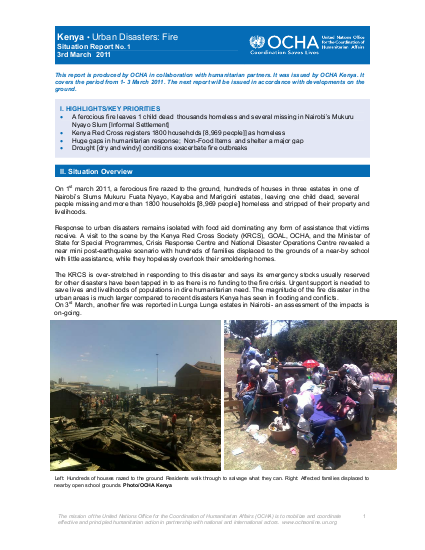
On 1st march 2011, a ferocious fire razed to the ground, hundreds of houses in three estates in one of Nairobi’s Slums Mukuru Fuata Nyayo, Kayaba and Marigoini estates, leaving one child dead, several people missing and more than 1800 households [8,969 people] homeless and stripped of their property and livelihoods.
Response to urban disasters remains isolated with food aid dominating any form of assistance that victims receive. A visit to the scene by the Kenya Red Cross Society (KRCS), GOAL, OCHA, and the Minister of State for Special Programmes, Crisis Response Centre and National Disaster Operations Centre revealed a near mini post-earthquake scenario with hundreds of families displaced to the grounds of a near-by school with little assistance, while they hopelessly overlook their smoldering homes.
The KRCS is over-stretched in responding to this disaster and says its emergency stocks usually reserved for other disasters have been tapped in to as there is no funding to the fire crisis. Urgent support is needed to save lives and livelihoods of populations in dire humanitarian need. The magnitude of the fire disaster in the urban areas is much larger compared to recent disasters Kenya has seen in flooding and conflicts. On 3rd March, another fire was reported in Lunga Lunga estates in Nairobi- an assessment of the impacts is on-going.
Resource collections
- Topics
- UN Habitat - Urban Response Collection
- Urban Response - Urban Crisis Preparedness and Risk Reduction
- Urban Response Collection - Community Engagement and Social Cohesion
- Urban Response Collection - Economic Recovery
- Urban Response Collection - Environment and Climate Change
- Urban Response Collection - Housing, Land and Property
- Urban Response Collection - Urban Crisis Response, Recovery and Reconstruction
- Urban Response Collection - Urban Resilience